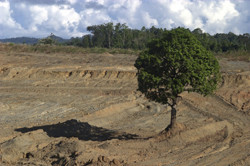Avoiding deforestation in Africa
Deforestation and the degradation of forests are responsible for about 20 % of global greenhouse gas (GHG) emissions. A strategy to reduce emissions from these processes was initiated by a group of developing countries in order to implement the Kyoto Protocol directives. The strategy can benefit from Earth observation (EO) and related data tools to estimate GHGs and to measure forest cover and land use. The EU-funded 'Reducing emissions from deforestation and degradation in Africa' (REDDAF)(opens in new window) project aimed to develop such forest monitoring services in Cameroon and the Central African Republic. REDDAF partners were tasked with advancing and testing better ways to use optical and radar EO data to assess deforestation/degradation. These processes will improve operational monitoring of forest cover and biomass changes in the two tropical countries. The project's technical tasks included defining user requirements, establishing cost-effective methods, integrating customised products and services, and validation. REDDAF also provided training to ensure that developed methods and techniques are transferred to the user community. In both countries, a large part of the project focused on assessing the needs in terms of training as well as technical requirements. From this process, REDDAF produced service-level agreements between the African users and international service providers. The next step was to develop methods to address country-specific challenges such as frequent cloud cover, and a lack of current methods in the region. These findings informed the development of locally relevant data products and services. Finally, REDDAF put these newly developed methods through a rigorous validation plan to ensure a high-quality product. Once this was complete, local users were given theoretical and practical training to better understand the new services. The REDDAF project has provided two African countries with advanced tools to monitor local deforestation and degradation. This will lead to improved conservation in the area, as well as an indirect mitigation of global climate change.



